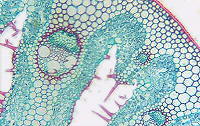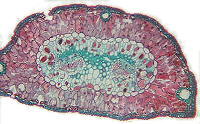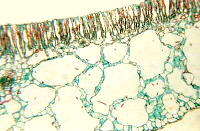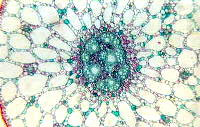 Stomata may be sunk
in pits in the epidermis; moist air trapped here lengthens the
diffusion pathway and reduces evaporation rate.
Stomata may be sunk
in pits in the epidermis; moist air trapped here lengthens the
diffusion pathway and reduces evaporation rate. Photosynthesis is the biological pathway whereby green plants make energy available to all living things. Plants exhibit a wide range of leaf form, however, typically a leaf comprises a thin lamella and large surface area. This enables effective photosynthesis by minimizing the distance between the photosynthesis factory (palisade cells) and the supply of raw materials (carbon dioxide and water). At the same time the large surface area maximizes light capture. To ensure that sufficient carbon dioxide can enter the plant when light energy is available, the stomata must be open, but this in turn allows water to evaporate from the large leaf surface during transpiration. In order to prevent the rate of transpiration exceeding water uptake but without compromising the needs for effective photosynthesis, plants have evolved a variety of adaptations to keep water loss by evaporation to a minimum.
In most dicotyledonous plants - the number of stomata is greater on the lower surface than on the upper. This arrangement ensures that carbon dioxide can enter the leaf while at the same time cutting down on transpiration rate (the lower surface being cooler than the upper). In addition, the stomatal mechanism of closing at night also reduces water loss by evaporation. Plants living in water deficient habitats have evolved further adaptations in order that water loss does not become critical. It is not just hot desert conditions and rapidly draining soils that can exert such pressures. In the tundra, soil water is frozen for long periods and so is unavailable to plants. Plants living at high altitudes and in exposed sites will be subjected to the drying effects of strong winds.
Plants growing in these conditions are termed xerophytes. Such plants need to minimize water loss by evaporation.
Many xerophytes have extensive root systems in order to trap available water. In addition there are other morphological adaptations to reduce the rate of transpiration.
Xerophytic plants may exhibit one or more of the following features.
Found in many evergreen leaves, the cuticle cuts down water loss in two ways: it acts as a barrier to evaporation and also the shiny surface reflects heat and so lowers temperature.
 Stomata may be sunk
in pits in the epidermis; moist air trapped here lengthens the
diffusion pathway and reduces evaporation rate.
Stomata may be sunk
in pits in the epidermis; moist air trapped here lengthens the
diffusion pathway and reduces evaporation rate.
 This adaptation is
found in Marram grass (Ammophila). As can be seen from the
image left, the inner surface is covered in hairs. The rolled
leaf and hairs both serve to trap moist air so reducing
transpiration. In addition, a smaller surface area of leaf is
exposed to the drying effects of the wind.
This adaptation is
found in Marram grass (Ammophila). As can be seen from the
image left, the inner surface is covered in hairs. The rolled
leaf and hairs both serve to trap moist air so reducing
transpiration. In addition, a smaller surface area of leaf is
exposed to the drying effects of the wind.

 Left-hand image heather (Erica),
right-hand image pine (Pinus).
Left-hand image heather (Erica),
right-hand image pine (Pinus).
Many xerophytic plants such as pine and heather, have small, needle shaped leaves which are often circular in cross section. This reduces the surface area and hence the evaporating surface.
Hydrophytic plants, in contrast to xerophytes are adapted to living in freshwater or very wet habitats. Water availability is therefore no problem. In fact hydrophytes often have reduced roots and water conducting tissue (xylem). The greatest problem faced by hydrophytes is how to obtain sufficient oxygen. Water logged soils have few, if any, air spaces, and what little oxygen there is, may be used in bacterial decay. In addition, oxygen has low solubility in water.
 Plants such as the
water lily (Nymphaea) and pond weed (Potamogeton)
are characterized by having large air spaces (lacunae) within
their tissue. These air filled spaces give the plant buoyancy,
allowing the leaf to float on or near the surface and so maximize
light capture. Oxygen produced by photosynthesis during the day
is trapped in the spaces and can diffuse to other parts of the
plant, enabling respiration.
Plants such as the
water lily (Nymphaea) and pond weed (Potamogeton)
are characterized by having large air spaces (lacunae) within
their tissue. These air filled spaces give the plant buoyancy,
allowing the leaf to float on or near the surface and so maximize
light capture. Oxygen produced by photosynthesis during the day
is trapped in the spaces and can diffuse to other parts of the
plant, enabling respiration.
In contrast to the leaves of many terrestrial plants, the stomata on floating leaves are found on the upper surface. This can be seen in the image of the section (shown left above) through the water lily leaf. In submerged leaves, stomata may not be present at all.
 The vascular tissue
(phloem and xylem) of aquatic stems is centrally arranged,
(unlike terrestrial plants where vascular tissue is cylindrically
arranged towards the outside of the stem). This central
arrangement which can be seen in the image (shown left) of the
pond weed, allows the stem to withstand the forces of water
currents.
The vascular tissue
(phloem and xylem) of aquatic stems is centrally arranged,
(unlike terrestrial plants where vascular tissue is cylindrically
arranged towards the outside of the stem). This central
arrangement which can be seen in the image (shown left) of the
pond weed, allows the stem to withstand the forces of water
currents.
Comments on the article to the author Anne Bruce
Editor's note: the Microscopy UK and Micscape Editors would like to thank Anne Bruce, who is a new contributor to Micscape magazine, for submitting this article.
Please report any Web problems
or offer general comments to the Micscape Editor,
via the contact on current Micscape Index.
Micscape is the on-line monthly
magazine of the Microscopy UK web
site at Microscopy-UK